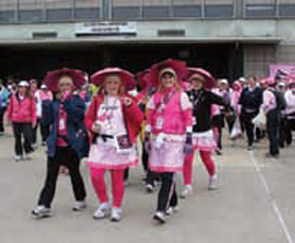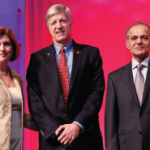
The months preceding the ACR meeting have been difficult for physicians and other healthcare providers in the United States as Congress debated the best way to reform our healthcare system, or at least healthcare insurance. While medicine is ultimately a matter that should be decided by patient and physician (or other healthcare provider), the political process seemingly neglected the opinions of this essential dyad. Rather, the discussion emanating from Washington involved the opinions of pundits, think tankers, spinmeisters, and other masters of the media whose job is to fashion our views.
I am a regular reader of the ACR Advocacy List Serve. I recommend it to anyone who would like to hear what rheumatologists say about their careers and lives. Always articulate, often impassioned, and sometimes cantankerous, the list serve provides a vital service for the ACR by providing a forum for members to express their views on key issues affecting our profession. Sometimes, the emails fly fast and furious. If, by chance, I have my BlackBerry strapped on my belt, my side zings and buzzes just about every minute as the list serve regulars sound the tocsin about one or another hot-button issue. The issues usually relate to the evil, nefarious, or unthinking ways of payers, whether public or private.

What About Patients?
While I was in Philadelphia, I began to think about how the founders of the ACR would view our current state. How would they weigh in on issues such as universal healthcare coverage and the merits of the public versus the private sector in assuring that our citizens have affordable healthcare and do not risk bankruptcy when illness strikes?
Philadelphia is an old city and the glitter of high-rise hotels like the Marriott and Loews cannot hide the troubles of its people. While it has some of the toniest urban and suburban enclaves in the country, Philadelphia has more than its share of the poor. Many on Market Street looked bedraggled and dressed in a style I called urban bundle: two hooded sweatshirts accessorized by a Phillies baseball cap and a shiver.
Near the Dunkin’ Donuts where I had my breakfast, every day a woman stood next to her shopping bag looking out into the street with fearful and vacant eyes. She wore a dirty wig and had red lipstick smeared wildly across her mouth. In front of her on the sidewalk, a legless woman shimmied and shook in a wheel chair as a man lip-synched to a Motown recording. What kind of healthcare did these people want or need? Have healthcare providers served as their advocates?
In the debate about healthcare, the voices of the people have been very quiet, likely because they lack the resources to make them louder and because they have few options for forging any common viewpoint. I cannot help but think that our citizens want decent and affordable care and do not particularly care whether it is provided by the public or private sector. For that matter, I think that most providers do not really worry about the structure of healthcare as long as it is fair and equitable and they would be more than happy if the discussion turned from so-called unnecessary care to unnecessary bureaucracy.
About one thing I am sure. The people in this country are great supporters of medical research and they want to make investments of the kind of science that, in rheumatology, has produced methotrexate, TNF blockers, bisphosphonates, and the myriad new agents for inflammation or pain on the horizon. Our people are deeply committed to improvements in care as embodied in the progress since the founding of the ACR during the dark days of The Depression.
About one thing I am sure. The people in this country are great supporters of medical research and they want to make investments of the kind of science that, in rheumatology, has produced methotrexate, TNF blockers, bisphosphonates, and the myriad new agents for inflammation or pain on the horizon.
A Different Kind of Research Support
On Sunday morning after the opening ceremony, I got up early to attend a lecture on the pathogenesis of rheumatoid arthritis by my good friend and collaborator, Steffen Gay, MD. Alas, blue laws are no longer in force, at least when it comes to scientific meetings. Although I think that Sunday morning should be a time for slumber, crossword puzzles, or church, the pressure to gain new knowledge and hours of continuing education credit have nullified the concept of a day of rest. Steffen gave a great lecture, although as soon as it was over, I rushed back to my hotel room to catch some needed shuteye.
On my way down Market Street to get to the Loews Hotel where I was staying, I noticed coming toward me a procession of people who were oddly dressed. Certainly, there were many people in the City of Brotherly Love who looked differently than the usual Durhamite, but these people, mostly women, seemed to be in costume. Many were wearing large pink foam rabbit ears that said “Energizer.” At that point, the weather was sill miserable, trying to rival that of the EULAR meeting in terms of the number of inches of cold rain that fell. On the walkers, plastic anoraks and raincoats were in full force, rather than long, black leather coats that the Philadelphians seem to like.
Intrigued, I stopped at the corner of 12th Street as waves of women in pink jackets, lace tutus, and billowing skirts came down Market Street under their umbrellas. Despite the pelting rain, the women seemed in high spirits, walking jauntily as they engaged in happy and animated conversation. I knew that this had to be a fundraiser of some kind and went up to one of the women to ask about the cause. The woman was middle-aged and was wearing a jacket slick with water. On the jacket were tens of tags with the names of women who were no doubt victims of disease.
The woman explained to me that this walk was to raise money for breast cancer research. The original plan called for three days of twenty miles each but, with the cold blast of the Nor’Easter, the organizers shortened it to one in the interest of safety. The goal for each woman was to raise $2,000. I figured that, with 2,500 walkers, the total gain would be about $5 million. While a lofty sum, $5 million is a drop in the research bucket of the NIH or that of any pharmaceutical company.
While I initially felt sad for these women as they trekked through downtown into a wall of driving rain, I soon became happy as I realized that they were making as strong a statement for the value of research as any I heard at the ACR meeting. These women had the right priorities. They knew what research can do and were prepared to give their all on a rain-drenched Sunday morning to make their contribution.
Whatever changes occur in the healthcare system, I hope that they meet the hopes and aspirations of those women, and no doubt millions of Americans, who, like the founders of the ACR, want better healthcare and are willing to sacrifice to make it happen.
Dr. Pisetsky is physician editor of The Rheumatologist and professor of medicine and immunology at Duke University Medical Center in Durham, N.C.

